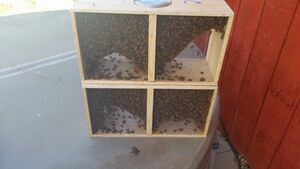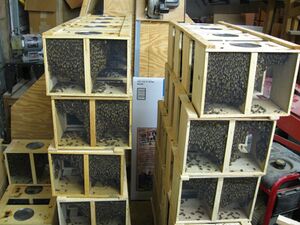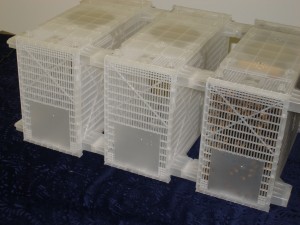Package
Package Bees
What is a package?
Typically sold in either 2, 3 or 4 lbs sizes - with 3lbs being the most common - a package is simply a box of bees with a mated, caged queen. Of course, there are a few more details - such as how the box is constructed (traditionally out of wood, with screens on 2 sides to allow adequate ventilation and the inclusion of a can of feed). But, basically you can think of a package as a box of bees.
(Often, packages are strung together in 'bricks' to make handling during shipping of dozens to hundreds of packages at a time much easier. The 'old school' method of separating packages was to use a saw and cut the corner sticks. This had the advantage of preventing any one side of the package being inadvertently placed next to an object, blocking ventilation.)
What do you do with a pakcage?
This means that you have to add the bees to their new hive and then establish them as a colony. Sometimes - random bees. Packages are often made en mass by dumping several hives worth of bees into a common collection box. Then weighing out 3lbs at a time into packages.
Establishing a package
A newly introduced package has quite the challenge ahead of them! Building comb, getting things ready so their queen can start laying and growing the colony takes energy and time. It also requires bees of the proper age! Younger workers are tasked with making wax and if by chance your package doesn't include an adequate number of these younger bees, it may be difficult for the colony to establish. Providing a new package with frames of drawn comb is a huge bonus and is to be encouraged.
Pros and Cons
Another advantage of packages, they're available earlier in the season. Usually late May. Typically, they've also been treated for mites and since there is no brood, no chance for hidden re-infestation. As they have no comb, there are no other hidden pests or diseases. Just what the bees themselves may have brought with them. It's very rare for a package to bring pathogens!
Packages are also relatively easy to introduce to non-Langstroth hives. Top Bars, Warre, etc. Since you don't have to transfer frames, don't have any brood to move over, etc.
One of the problems occasionally seen with package bees, is the mated queen doesn't perform. She may have just been mated the week before packages were made and may well not have been laying, yet. The shipping delay can keep her from getting going and laying a good, solid pattern - even if drawn comb is available. There's also the slight risk of the queen not being accepted for some reason.
Packages are a common method of buying bees for new hives. But, they do require more effort and care to establish than alternatives (swarms, nucs or complete hives). There are simply more opportunities for things to go wrong. The rate of successful establishment amongst new, just starting out beekeepers isn't stellar.
Bee Bus packags
These days, many producers are moving to the new 'Bee Bus' package instead of the traditional wood and screen box. These packages are re-usable. They also snap together, sort of like "Lego" blocks, to make larger bricks for shipping.
Shipping packages
In times past, the US Post Office would often be the carrier for packages. There are many stories around of Postal carriers delivering new packages and post offices dealing with unexpected visitors escaped from their packages. These days, that's all but stopped. Most producers won't trust the USPS with packages. Too many dead or sick packages delivered and producers eating those losses have become intolerable. These days, It's expected for the beekeeper to go to a pick-up site - often out of town - and bring their own packages home.



